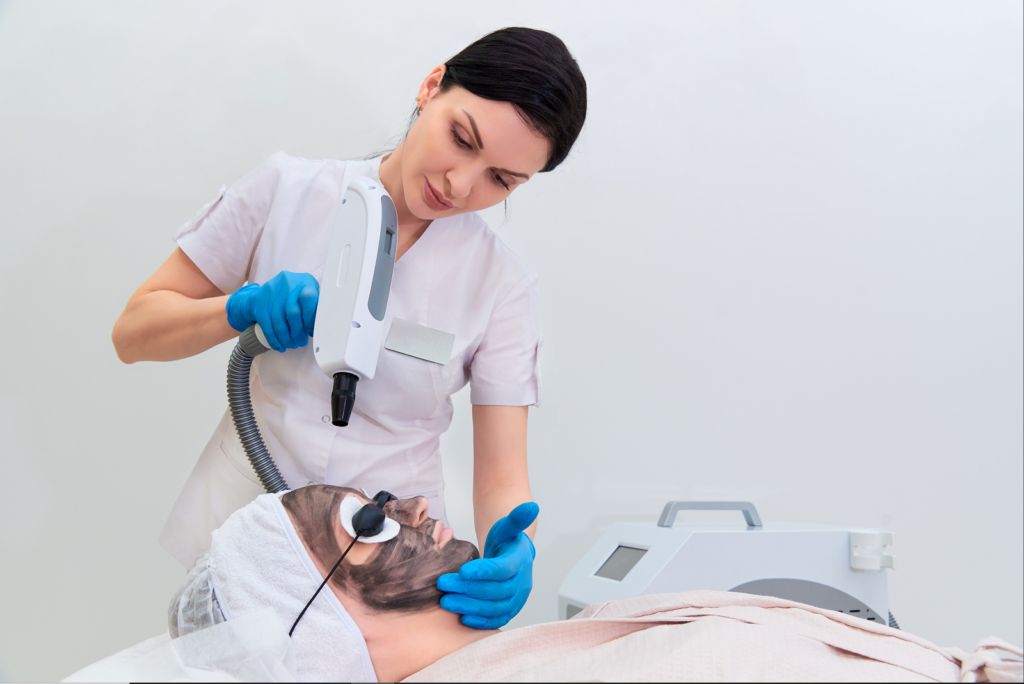Carbon Laser Peel Treatment in Islamabad
Carbon laser, often referred to as the “Carbon Laser Peel” or “Carbon Laser Facial,” is a cosmetic dermatological procedure that uses laser technology, specifically a Q-switched Nd:YAG laser, to rejuvenate and improve the appearance of the skin. Here’s an explanation of the carbon laser procedure:
Procedure Overview
The carbon laser procedure, often referred to as carbon laser peel or carbon laser facial, is a non-invasive skin treatment that combines the application of a liquid carbon solution and the use of a specialized laser to improve the appearance and health of the skin. Here’s an overview of how the procedure works:
Application of Liquid Carbon:
The first step of the procedure involves applying a thin layer of liquid carbon (activated carbon) to the surface of the skin, typically on the face. This liquid carbon solution is usually in the form of a carbon cream or mask.
Carbon Penetration:
The carbon particles in the solution have a dark color, making them highly absorbent to laser energy. The carbon layer is allowed to dry, during which time it adheres to the skin’s surface and penetrates into the pores. This is important because the carbon particles help to target and treat specific skin issues, such as clogged pores and excess oil.

Laser Treatment
Once the carbon layer has dried and is securely in place, a Q-switched Nd:YAG laser is employed.
The Q-switched Nd:YAG laser emits high-energy, focused light in extremely short pulses. This laser is specifically chosen for its ability to target the dark carbon particles while minimizing damage to the surrounding skin.
The laser is directed at the skin, and it is used to heat and vaporize the carbon particles that have been absorbed into the pores.
Beneficial Effects on the Skin
- The interaction between the laser and the carbon particles results in several positive effects on the skin, including:
- Exfoliation: The laser’s heat causes the carbon to vaporize, along with any impurities and dead skin cells within the pores. This effectively exfoliates the skin and cleans out the pores.
- Skin Rejuvenation: The heat from the laser stimulates collagen production, which can help improve skin texture and reduce the appearance of fine lines and wrinkles.
- Reduction of Pigmentation: The procedure can also help reduce the appearance of pigmentation issues, such as age spots and uneven skin tone.
- Oil and Acne Control: By clearing out clogged pores and reducing excess oil production, the procedure can be effective in managing acne and minimizing the appearance of large pores.
Minimal Downtime
One of the advantages of the carbon laser procedure is that it typically has minimal downtime. Patients may experience mild redness and some peeling for a short period after the treatment, but they can usually return to their regular activities relatively quickly.
Exfoliation
The laser energy interacts with the carbon particles and causes them to vaporize, exfoliating the top layer of dead skin cells on the skin’s surface. This exfoliation process is sometimes referred to as “skin resurfacing.”
Stimulated Collagen Production
The heat generated by the laser energy also stimulates the production of collagen, a crucial protein for skin elasticity and firmness. The collagen remodeling process helps to improve the skin’s texture, reduce fine lines and wrinkles, and promote a more youthful appearance.
Pore Cleansing
The carbon particles, when applied to the skin, are absorbed into the pores. When the laser is used, it helps to clean out and shrink the pores, reducing the appearance of blackheads and acne.
Skin Rejuvenation
The combination of exfoliation, collagen stimulation, and pore cleansing results in skin rejuvenation. The treatment can lead to a smoother, more even-toned complexion with improved skin texture.
Reduction of Pigmentation
Reduction of pigmentation is one of the beneficial effects of carbon laser treatments. These treatments can effectively target and reduce the appearance of various pigmentation issues on the skin, including sunspots, age spots, and melasma. Here’s how carbon laser treatments work to achieve this reduction in pigmentation:

Targeted Laser Energy
During a carbon laser treatment, a Q-switched Nd:YAG laser is used to emit high-energy, focused light in extremely short pulses. The wavelength of this laser is specifically chosen to target and interact with the dark carbon particles that have been applied to the skin. This laser energy is absorbed by the carbon particles, leading to a controlled and localized heating effect.
Breakdown of Pigmentation
The laser’s energy is absorbed not only by the carbon but also by the pigmented areas of the skin. This heat energy causes the pigmented cells to break down. Melanin, the pigment responsible for skin color, is the main target in this process. The laser disrupts and fragments the melanin, which is responsible for the dark pigmentation seen in issues like sunspots, age spots, and melasma.
Stimulation of Skin’s Natural Healing Response
As the laser treats the pigmented areas, it also stimulates the skin’s natural healing response. This includes the production of new collagen, which is an essential protein for skin health and appearance. The increased collagen production can help to even out skin tone and reduce the appearance of pigmented spots over time.
Exfoliation and Skin Renewal
The heat generated by the laser also encourages the shedding of the top layer of the skin, which may contain some of the pigmented cells. This exfoliation process can further contribute to a more even skin tone and the reduction of pigmentation issues.
Gradual Improvement
It’s important to note that the reduction of pigmentation with carbon laser treatments is usually a gradual process. Multiple treatment sessions may be required to achieve the desired results, and improvement may continue over time as the skin heals and regenerates.
Post-Treatment Care
After the procedure, it’s essential to take good care of your skin, protecting it from excessive sun exposure, as UV rays can exacerbate pigmentation issues. Applying sunscreen and following your healthcare provider’s post-treatment instructions are crucial to maintaining the results and preventing the reappearance of pigmentation problems.
Quick and Minimal Discomfort
Carbon laser procedures are relatively quick and generally cause minimal discomfort. Patients often report a mild warming sensation during the treatment. The procedure is well-tolerated and typically requires little to no downtime.
Multiple Sessions
To achieve optimal results, a series of carbon laser sessions may be recommended, usually spaced a few weeks apart.
Carbon laser treatments are generally considered safe and are performed by qualified medical professionals, such as dermatologists or licensed practitioners. However, as with any cosmetic procedure, it’s essential to consult with a healthcare provider to determine if it’s suitable for your skin type and specific concerns. Carbon laser treatments have become a popular choice for those seeking non-invasive skin rejuvenation and improvements in skin texture and tone.
Consultation with a Professional
If you’re interested in scheduling a consultation, we encourage you to reach out by sending a message through the contact details provided via WhatsApp or by giving us a call. We’re here to assist you in setting up an appointment, answering any questions you may have, and ensuring a smooth and convenient booking process.
Your well-being and satisfaction are our top priorities, and we look forward to assisting you every step of the way.


